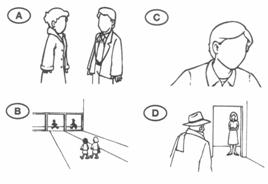艺术话题(B)
|
6. |
What is the
lecture mainly about? | |
|
|
A |
Media of
the twentieth century |
|
|
B
|
The
development of film style |
|
|
C |
How film
criticism influenced art |
|
|
D |
The film
techniques of D.W. Griffith |
|
7. |
Which of
the following contribute to the style of a
film? | |
|
Click
on two answers. | ||
|
|
A |
Theater
design |
|
|
B
|
Acting
awards |
|
|
C |
Camera
framing |
|
|
D |
Film
cutting |
|
8. |
According
to the professor, why did early film critics dislike films that resembled
theater? | |
|
|
A |
They did
not understand the traditions of theater. |
|
|
B
|
They felt
that films should not be shown in
theaters |
|
|
C |
They
thought that film was a distinct art
form. |
|
|
D |
They
disagreed with the politics of theater
owners. |
|
9. |
Why does
the professor discuss cross-cutting? | |
|
|
A |
To give an
example of an early advancement in film
style |
|
|
B
|
To explain
why film critics disliked certain types of
films |
|
|
C |
To describe
a technique that confused early film
audiences |
|
|
D |
To convince
students that film should be regarded as high art
|
|
10. |
Listen
again to part of the lecture.Then answer
the question. | |
|
|
A |
D. techniques
we use today. |
|
|
B
|
The actors
in Griffith’s films always spoke with perfect grammar. |
|
|
C |
Critics
liked Griffith’s films,but
audiences did not understand them. |
|
|
D |
D. |
|
11. |
Which
camera shot would probably best show that a character is
frightened? | |

Test 6 29-34
|
|
|
29. |
What is the
main idea of the lecture? | |
|
|
A |
People
should protest against war photography. |
|
|
B
|
Photographers recorded the battle at
Antietam. |
|
|
C |
The
battlefield is too dangerous for photographers. |
|
|
D |
Photography
changed the nature of war reporting. |
|
30. |
Listen
again to part of the lecture.Then answer
the question. | |
|
|
A |
More
Americans died on that day than on any other day. |
|
|
B
|
Antietam
was the only battle in which Americans died. |
|
|
C |
Deaths were
counted for the first time at Antietam. |
|
|
D |
Civil
War. |
|
31. |
Who was
Mathew Brady? | |
|
|
A |
A military
leader during the Civil War |
|
|
B
|
A portrait
painter in |
|
|
C |
The owner
of a photography business |
|
|
D |
The
inventor of photography |
|
32. |
Why does
the professor say this:
| |
|
|
A |
To warn
students not to look at the pictures |
|
|
B
|
To
encourage students to study photography |
|
|
C |
To contrast
different photographic styles |
|
|
D |
To
emphasize the power of photography |
|
33. |
What were
some of the limitations of photography during the Civil
War? | |
|
Click
on two answers. | ||
|
|
A |
The slow
exposure time did not allow action shots. |
|
|
B
|
Photographers were not permitted on the
battlefield. |
|
|
C |
Newspapers
were not able to reproduce photographs. |
|
|
D |
There were
only a few schools that taught
photography. |
|
34. |
What does
the professor imply about Mathew Brady? | |
|
|
A |
He was
unfairly criticized for his photographs of the dead. |
|
|
B
|
His work
had a lasting effect on photography and
journalism. |
|
|
C |
He took
more photographs during his life than anyone else did. |
|
|
D |
His Civil
War photographs are worth a lot of money today. |
|
|
|
|

Stop
考点:
笔记:
Mass
media
Movie
High-art
Cinema, the defining art
form
Own style,
distinct
Film style,
定义:texture, systemic use of
tech. Eg.
Silent
era
Most notcieble
Cutting
Film like
theater
Did not like film like
theater
However, new,
Stylistic
Editing ,most ipmor
tech
Cutting, key to
artistry
Cross-cutting. Two stories
at the same time
定义:不用及
1903, robbery,
听就可以了
Person: DW
G
Not.. acturally, define and
refine..
Uniqe narrative
form
Perfect film
grammar
Editing…
Introduced analytical
editing
Close-ups
Subtle changes in eyes,
moth.
1.
主题:
2.
细节:film
style
3.
细节:dislike考否定词
4.
细节:cross-cutting
5.
重放:DW, 人物,必考成就
6.
细节:close-ups
艺术话题背景知识
艺术
Genre 艺术分类
Performing art 表演艺术
modern dance piece现代舞
concert 音乐会
play剧
opera歌剧
film 电影
ballet芭蕾舞 belly dance
Literature
Poetry诗歌
biography传记
autobiography 自传
detective stories 侦探小说 moon
drama戏剧
novel小说
collection of short
stories短篇小说集
Fine/visual arts 视觉艺术
Abstract art抽象艺术
Concrete
a landscape风景
photography摄影
portrait(portray v. )肖像, 人像model模特
starry night
pigmentation
spectrum
a still life静物
a sculpture雕塑
statue 人物雕像
Critic 评论家
Criticism 批评,评论
Review n.评论
Masterpiece 杰作
Have aesthetic value
Aesthetic appeal 美学吸引力
Features 特点
Characteristics 特点
Distinct adj.与众不同的
Unique 独一无二的
Style 风格
Gallery n.画馆
Edition n.专辑
Release v. 发行
Debut n.首映
Impressionist 印象主义者
Impressionism 印象派
Romanticism
Simple language, common
people
Interaction
Flowery
Perspective 透视法
Angle 角度
Press/Publishing house出版社
Preserve v. 保存
Extinct adj.灭绝的,消失的
Acclaim v. 盛赞
Novelist 小说家
Flowery 花哨的
anthem 国歌
mural 壁画
mirage 海市蜃楼
productive
prolific 多产